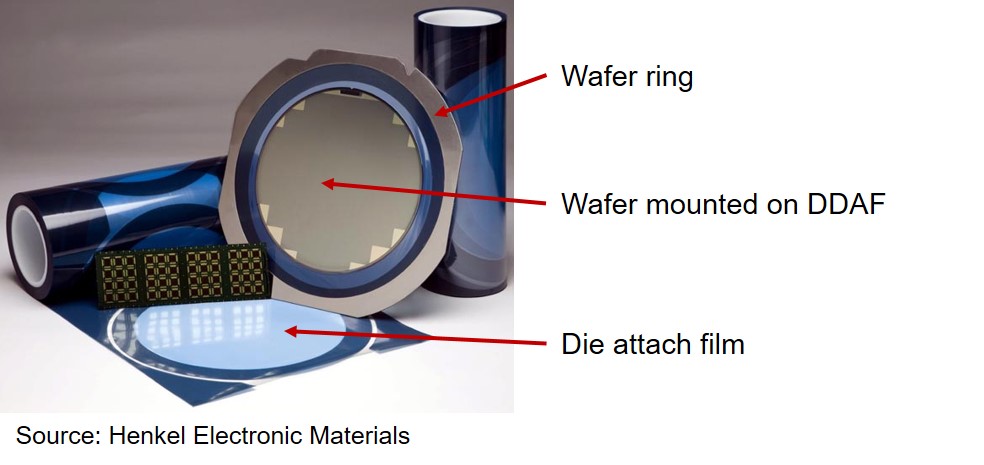I trust everyone had a nice Fourth of July holiday and had some time to relax with family and friends. We pick-up in this post with more information on film die attach. As was discussed previously, the requirement for uniform, thin bondlines drives the die attach design. Dicing Die Attach Film (DDAF) is the most common type of die attach film used in die stacking. The DDAF concept includes both the dicing tape and the die attach film laminated together. The image above shows several features of the DDAF product.
On the roll, the dark blue is the dicing tape, which is a stretchy film used to separate the individual chips after dicing facilitating the pick-and-place and die stacking process. The die attach film is the white circle (light blue in the photo above) and it is laminated onto the dicing tape during the manufacturing process to make the DDAF. The wafer is mounted face-up on the die attach film and the wafer ring is then adhered to the dicing tape as seen in the right side of the photo.
The cross section of the DDAF mounted on the wafer ring is shown in the next image.
In the cross-section above the die attach film is the light grey layer. In order to get good wetting and adhesion of the die attach film to the wafer, the chemistry is designed for ease of coating onto a release liner (removed prior to wafer mount) and B-staged to have good film properties (H. Jin, US20100279469 A1). This patent application describes a composition comprising a toughened polymer, a curable resin, a curing agent for the curable resin, and a void reduction compound that can also be cured into the final network. The curable resins are bismaleimide and epoxy (similar to the chemistries discussed in a previous post) to get low moisture absorption and good wetting and adhesion during wafer bonding. After coating the composition onto a suitable carrier such as polyethylene terephthalate (PET) the resin composition is B-staged to produce a partially cured adhesive with film-like properties. The B-staging process takes advantage of the unique aspects of thermosets. Typically, a dual chemistry approach is used. The B-staging utilizes a low temperature curing reaction to form a chain-extended (linear) compound that has the right amount of tack, but is below the gel point allowing subsequent flow during the wafer mounting process. A second higher temperature curing reaction (usually greater than 30-40°C higher) is used to fully cure both the low temperature resins and the second, higher temperature network. The combination of the right amount of linear chains in a thermoset network (interpenetrating network structure) is the key to making the DDAF film work properly in die stacking.
The following figure shows the DDAF stacking process flow:
The process starts with mounting the wafer onto the DAF and the UV dicing tape. The combination of the DAF and the UV dicing tape has to have enough toughness to withstand the dicing process. In the dicing process (it’s a funny name, but it is a sawing process to cut individual die or chip from the wafer) the saw must cleanly cut the silicon wafer, cut through the DAF and not cut through the dicing tape. The DAF must adhere well to the wafer and to the dicing tape. If there is a loss of adhesion to either surface the die will pop off the tape (die fly) during dicing. Die fly creates a yield impact since the die is not going to be able to be mounted. The film formulators challenge is to have very high adhesion to the wafer (die) back and adequate adhesion to the dicing tape during the sawing operation, but still allow for release off the dicing tape after dicing.
In order to solve this dilemma, UV dicing tape is used. The PSA on the dicing tape is formulated to have high adhesion to the DAF to reduce/eliminate die fly, but can be UV cured to lower the adhesion between the DAF and the dicing tape PSA. More thermoset chemistry at work. After UV exposure, the adhesion decreases since the Tg and modulus can be increased and the surface chemistry changes to get “bad” adhesion. As discussed in previous posts, UV curing is a very useful part of the thermoset toolbox.
The next step is the die pick-up where a high speed pick-and-place machine “picks” the die with the DAF on the backside and places either on the substrate (mother die) or on top of the mother die (daughter die). The UV exposure allows the DAF to cleanly release from the dicing tape. A heated collet is used to pick the die and a pin is used on the bottom side of the dicing tape to help stretch the dicing tape and intiate a peel force to release the DAF from the dicing tape. The heated collet softens the DAF to allow for good flow, wetting, and adhesion to the substrate or mother die. As you can see, there is a lot of chemistry and engineering going on. Who knew all of this is part of what makes your smartphone work!
In the next post we will discuss the various types of die stacking processes.




Hi Sir,
This is Taiwan agent company.
I am looking for die attach film for Taiwan semi package market.
If you have any product, please let us discuss more detail, thanks.
Best Regards
Hans
InnoCentrix does not have die attach film. We are a consulting company.
Hello Jeff Gotro,
Thank you for your real nice and informative DDAF paper blog.
I am retired from ADT previous K&S and in the process of writing a technical article “THE ART OF DICING MICROELECTRONIC SUBSTRATES”. Could you please advise what wafer mounters are used for mounting the DDAF tapes. Also can I use the above HENKEL ELECTRONIC nice photo in my article.
Thanks you and stay safe.
Gideon Levinson